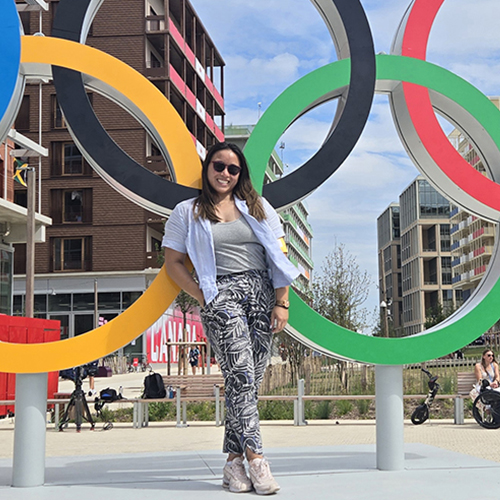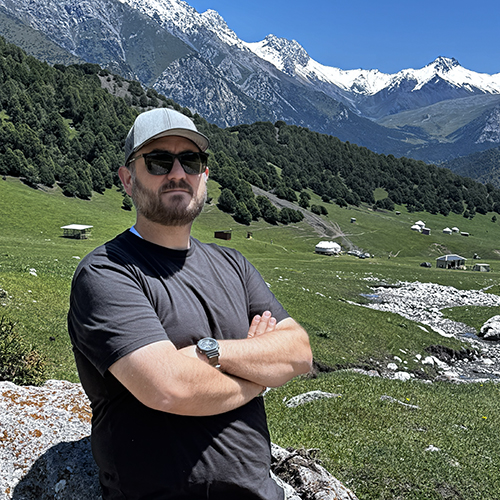More than a dozen kayaks line the shore of Lake Washington, packed together like brightly colored sardines. Before long the boats will be on the water, piloted by UW students and enthusiastic sixth graders armed with water testing equipment.
It’s the final day of Science by Kayak, a program offered each spring by the UW Department of Chemistry in conjunction with TOPS, a K-8 school in Seattle. UW science students visit sixth graders at TOPS, and later at Lake Washington, accompanying them to conduct science experiments with real-world applications.

Science by Kayak was introduced in 2001 by TOPS parent Mary Harty, who
was then the outreach coordinator for the UW Chemistry Department. It was TOPS’s physical education teacher, she says, who provided the germ of the idea.
“The P.E. teacher was always coming up with interesting activities,” recalls Harty, now a Chemistry Department adviser. “He knew I worked in the sciences and asked if we could do something science-related with kayaks. I thought it sounded like a great idea.”
Harty had experience coordinating science outreach projects and had science kits available. The challenge, she says, was figuring out “what sixth graders could wrap their heads around.” She decided on three experiments: a water pH test; a test of dissolved oxygen in water; and a test focusing on natural dyes.
With experiments selected and with financial support from Zymogenetics, Harty created a course designed to involve UW students in the program. The course prepares undergraduates to work with the sixth graders, first in the classroom and later in the field. The UW students learn the experiments, develop presentations on related science topics, and even spend an afternoon honing their kayaking skills, which they need when assisting TOPS students during the Lake Washington field trip.
“The course is an elective, so we get a lot of seniors who want to have a fun experience at the end of their time at the UW,” says Harty. “Most, but not all, are chemistry or biology majors.”
Some are drawn by the opportunity to work with middle school students. That was the case for Jun Chungsiriwat (’06), a biochemistry major who participated during both her junior and senior years. “I love science and I wanted to share my love of science with the students,” she says. “The kids made such a good impression on me with their eagerness to learn that I went back the second year.”
The sixth graders tend to be impressed with the UW students as well. “They idolize them,” says Darin Durand, a former TOPS teacher who participated in Science by Kayak in 2005 and 2006. “I started referring to the UW students as ‘rock stars.’” TOPS science teacher Guy Lawrence finds that his sixth graders’ interest in science is piqued when they learn that their UW visitors are science majors. “The UW students’ involvement is what really makes this program work,” he says.

It also helps that the lab experiments are kid friendly. The pH test is the most popular. The test involves variations in color that indicate changes in the pH, or acidity, of water. “Because the experiment looks like a magic show, with water turning green and red, the students are drawn to it,” says Chungsiriwat. “Like the students, I enjoy the appearance of a little magic here and there, so I liked the pH testing experiment best as well.”
Students also test the level of dissolved oxygen in water, using a classic chemistry technique called titration. “It’s something every freshman chemistry student gets to do again and again and again,” says Harty, who explains that a high level of dissolved oxygen in water is desirable for fish and other aquatic life.
The third experiment tests the change in natural dyes when metal ions are added. “Metal ions are simply rocks,” says Harty, “and adding them really does change the color of the dyes.” The experiment has an added component: ethnobotany. When the UW students introduce the natural dye experiment—using dyes made with carrot tops, yellow onion skins, red alder bark, and other natural materials—they discuss the use of plants in Native American culture to create everything from dyes to medicines. “I see this as an opportunity to show, through Native American culture, that we’ve been doing science all along,” says Harty.
Once the students have mastered all three experiments, it’s time for the field trip. Over the course of a full school day, the group hikes through the Arboretum searching for native plants and piles into kayaks to conduct water testing. Most students are excited, but some are nervous as well.

“Some students who haven’t kayaked before are scared,” says Durand. “But others are able to reassure them that double kayaks are very stable. There’s also one triple kayak, and that one is like a tank.”
The sixth graders are not the only ones who experience trepidation. Some UW students have their own concerns about the outing. “They really enjoy the training sessions and the sessions at the school because they are controlled,” says Harty. “Then they get in the kayaks and ask themselves, ‘What was I thinking?’ But in the end, everyone has a blast. It’s a win-win experience.”
Durand believes the field experience is particularly valuable for students who learn best outside the classroom. “Due to different learning styles, some kids can show much more of what they know in the field than in the classroom,” he says. “There were students who were on the edge of failing in class who absolutely thrived on the field experience. Knowing that they would be repeating their lab experiments in the field made a difference. Understanding the experiments’ relevance really helped activate the students’ learning.”
After seven years, Harty still relishes watching students head out in kayaks with their water testing equipment, even if the kayaks do resemble bumper cars until the students learn how to control them. TOPS teacher Marianne Trangen also has participated in every kayak trip since the beginning.
“Each year, I see our students take pride in doing actual water testing, where they get real results,” says Trangen. “If they do the testing right, it works. If not, it doesn’t. They get immediate feedback. Years later, I’ve had former students mention this as one of their most memorable experiences at TOPS."
More Stories

A Sports Obsession Inspires a Career
Thuc Nhi Nguyen got her start the UW Daily. Now she's a sports reporter for Los Angeles Times, writing about the Lakers and the Olympics.

Through Soil Science, an Adventure in Kyrgyzstan
Chemistry PhD alum Jonathan Cox spent most of 2025 in Kyrgyzstan, helping farmers improve their soil—and their crops—through soil testing.

A Healing Heart Returns
In February, the UW Symphony will perform a symphony that Coast Salish elder Vi Hilbert commissioned years ago to heal the world after the heartbreak of 9/11. The symphony was first performed by the Seattle Symphony in 2006.